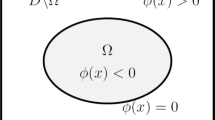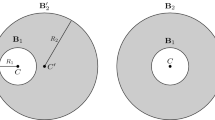Abstract
We consider to solve numerically the shape optimization models with Dirichlet Laplace eigenvalues. Both volume-constrained and volume unconstrained formulations of the model problems are presented. Different from the literature using boundary-type Eulerian derivatives in shape gradient descent methods, we advocate to use the more general volume expressions of Eulerian derivatives. We present two shape gradient descent algorithms based on the volume expressions. Numerical examples are presented to show the more effectiveness of the algorithms than those based on the boundary expressions.














Similar content being viewed by others
References
Bendsøe, M.P., Sigmund, O.: Topology Optimization. Theory, Methods and Applications. Springer, Berlin (2003)
Delfour, M.C., Zolésio, J.-P.: Shapes and Geometries: Metrics, Analysis, Differential Calculus, and Optimization, 2nd edn. SIAM, Philadelphia (2011)
Pironneau, O.: Optimal Shape Design for Elliptic Systems. Springer, New York (1984)
Sokołowski, J., Zolésio, J.-P.: Introduction to Shape Optimization: Shape Sensitivity Analysis. Springer, Heidelberg (1992)
Henrot, A., Pierre, M.: Variation et Optimisation de Formes: Une Analyse Géométrique, vol. 48. Springer, Berlin (2005)
Allaire, G., Pantz, O.: Structural optimization with FreeFem++. Struct. Multidisc. Optim. 32, 173–181 (2006)
Liu, C., Dong, F., Zhu, S., Kong, D., Liu, K.: New variational formulations for level set evolution without reinitialization with applications to image segmentation. J. Math. Imaging Vis. 41, 194–209 (2011)
Liu, C., Zhu, S.: A semi-implicit binary level set method for source reconstruction problems. Int. J. Numer. Anal. Model. 8, 410–426 (2011)
Zhu, S., Dai, X., Liu, C.: A variational binary level-set method for elliptic shape optimization problems. Int. J. Comput. Math. 88, 3026–3045 (2011)
Zhu, S., Liu, C., Wu, Q.: Binary level set methods for topology and shape optimization of a two-density inhomogeneous drum. Comput. Methods Appl. Mech. Eng. 199, 2970–2986 (2010)
Zhu, S., Wu, Q., Liu, C.: Variational piecewise constant level set methods for shape optimization of a two-density drum. J. Comput. Phys. 229, 5062–5089 (2010)
Zhu, S., Wu, Q., Liu, C.: Shape and topology optimization for elliptic boundary value problems using a piecewise constant level set method. Appl. Numer. Math. 61, 752–767 (2011)
Zhu, S., Hu, X., Wu, Q.: A level set method for shape optimization in semilinear elliptic problems. J. Comput. Phys. 355, 104–120 (2018)
Brenner, S.C., Scott, L.R.: The Mathematical Theory of Finite Element Methods, 3rd edn. Springer, New York (2008)
Antunes, P.R.S., Freitas, P.: Numerical optimization of low eigenvalues of the Dirichlet and Neumann Laplacians. J. Optim. Theory Appl. 154, 235–257 (2012)
Hiptmair, R., Paganini, A., Sargheini, S.: Comparison of approximate shape gradients. BIT Numer. Math. 55, 459–485 (2015)
Laurain, A., Sturm, K.: Distributed shape derivative via averaged adjoint method and applications. ESAIM Math. Model. Numer. Anal. 50, 1241–1267 (2016)
Bucur, D., Buttazzo G.: Variational Methods in Shape Optimization Problems. Progress in Nonlinear Differential Equations and their Applications, vol. 65, Birkhäuser Boston (2005)
Bucur, D.: Minimization of the \(k\)th eigenvalue of the Dirichlet Laplacian. Arch. Ration. Mech. Anal. 206, 1073–1083 (2012)
Buttazzo, G., Belhachmi, Z., Bucur, D., Sac-Epee, J.M.: Shape optimization problems for eigenvalues of elliptic operators. ZAMM Z. Angew. Math. Mech. 86, 171–184 (2006)
Courant, R., Hilbert, D.: Methods of Mathematical Physics, vol. I. Interscience, New York (1953)
Henrot, A.: Extremum Problems for Eigenvalues of Elliptic Operators. Birkhauser, Basel (2006)
Allaire, G., Aubry, S., Jouve, F.: Eigenfrequency optimization in optimal design. Comput. Methods Appl. Mech. Eng. 190, 3565–3579 (2001)
Oudet, E.: Numerical minimization of eigenmodes of a membrane with respect to the domain. ESAIM Control Optim. Calc. Var. 10, 315–330 (2004)
Kao, C.Y., Su, S.: Efficient rearrangement algorithms for shape optimization on elliptic eigenvalue problems. J. Sci. Comput. 54, 492–512 (2013)
Osting, B., Kao, C.Y.: Minimal convex combinations of sequential Laplace–Dirichlet eigenvalues. SIAM J. Sci. Comput. 35, B731–B750 (2013)
Rousselet, B.: Shape design sensitivity of a membrane. J. Optim. Theory Appl. 40, 595–623 (1983)
Ashbaugh, M.S., Benguria, R.: A sharp bound for the ratio of the first two eigenvalues of Dirichlet Laplacians and extensions. Ann. Math. 135, 601–628 (1992)
Wolf, S.A., Keller, J.B.: Range of the first two eigenvalues of the Laplacian. Proc. R. Soc. Lond. Ser. A Math. Phys. Sci. 447, 397–412 (1994)
Hecht, F.: New development in freefem++. J. Numer. Math. 20, 251–265 (2012)
Acknowledgements
This work was supported in part by the National Natural Science Foundation of China under Grants 11201153, 11301129 and 11571115.
Author information
Authors and Affiliations
Corresponding author
Additional information
Communicated by Zenon Mróz.
Appendix A: Shape Sensitivity Analysis
Appendix A: Shape Sensitivity Analysis
Lemma A.1
(Theorem 2.5.3 [22]) Let \(\varOmega \) be an open and bounded domain. Then, the Eulerian derivative reads:
If, moreover, \(\varOmega \) is Lipschitz, then
For a function \(u(x):\varOmega \rightarrow \mathbb {R}\) and its perturbation \(u_t(x_t):[0,\tau ]\times \mathbb {R}^d\rightarrow \mathbb {R}\), we have
Definition A.1
The material derivative of a state variable u in a direction \(\mathcal {V}\) is denoted as
if the limit exists.
Definition A.2
The shape derivative of u in a direction \(\mathcal {V}\) is defined by
In the following, we omit the subscript l of \(\lambda _l\) and \(u_l\) for simplicity. The following result holds (see Theorems 2.5.1 [22] and 4.2 [2]). We give a heuristic derivation for the sake of completeness.
Proposition A.1
Let \(\varOmega \) be an open bounded domain. Assume that the first Dirichlet eigenvalue \(\lambda =\lambda (\varOmega )\) is simple. Then, \(\lambda (\varOmega )\) is shape differentiable and the Eulerian derivative
If, furthermore, \(\varOmega \) is convex or if it is of class \(C^2\), then
Proof
We only derive (13) formally below for simplicity. The derivation of volume formulation (12) can be performed similarly. For a test function \(\phi \in H^1(\varOmega )\) with compact support \(\omega \subset \varOmega \), we have
Differentiating with respect to \(\varOmega \) implies that
where \(u^\prime :=u^\prime (\varOmega ;\mathcal {V})\) and \(\lambda ^\prime :=\lambda ^\prime (\varOmega ;\mathcal {V})\). By integration by parts, we have
To derive the boundary condition, we have
Taking the Eulerian derivative implies that
where \(\kappa \) denotes the mean curvature. Thus,
since \(u=0\) on \(\partial \varOmega \).
Multiplying Eq. (14) by u and integrating by parts leads to
Multiplying the equation for u by \(u^\prime \) and integrating by parts leads to
Thus, a combination of the two equations above yields that
from which we obtain the result after using (15) and the normalization \(\int _\varOmega u^2\,\mathrm{d}x=1\). \(\square \)
Proposition A.2
Let \(\varOmega \) be an open bounded domain. For \(J(\varOmega )=|\varOmega |\lambda (\varOmega )\), we have
If, moreover, \(\varOmega \) is convex or \(C^2\), then
Proof
First, we perform the product rule for Eulerian derivatives
Then, we obtain (6)–(7) and (9)–(10) by combining Proposition A.1 and Lemma A.1. \(\square \)
Rights and permissions
About this article
Cite this article
Zhu, S. Effective Shape Optimization of Laplace Eigenvalue Problems Using Domain Expressions of Eulerian Derivatives. J Optim Theory Appl 176, 17–34 (2018). https://doi.org/10.1007/s10957-017-1198-9
Received:
Accepted:
Published:
Issue Date:
DOI: https://doi.org/10.1007/s10957-017-1198-9




